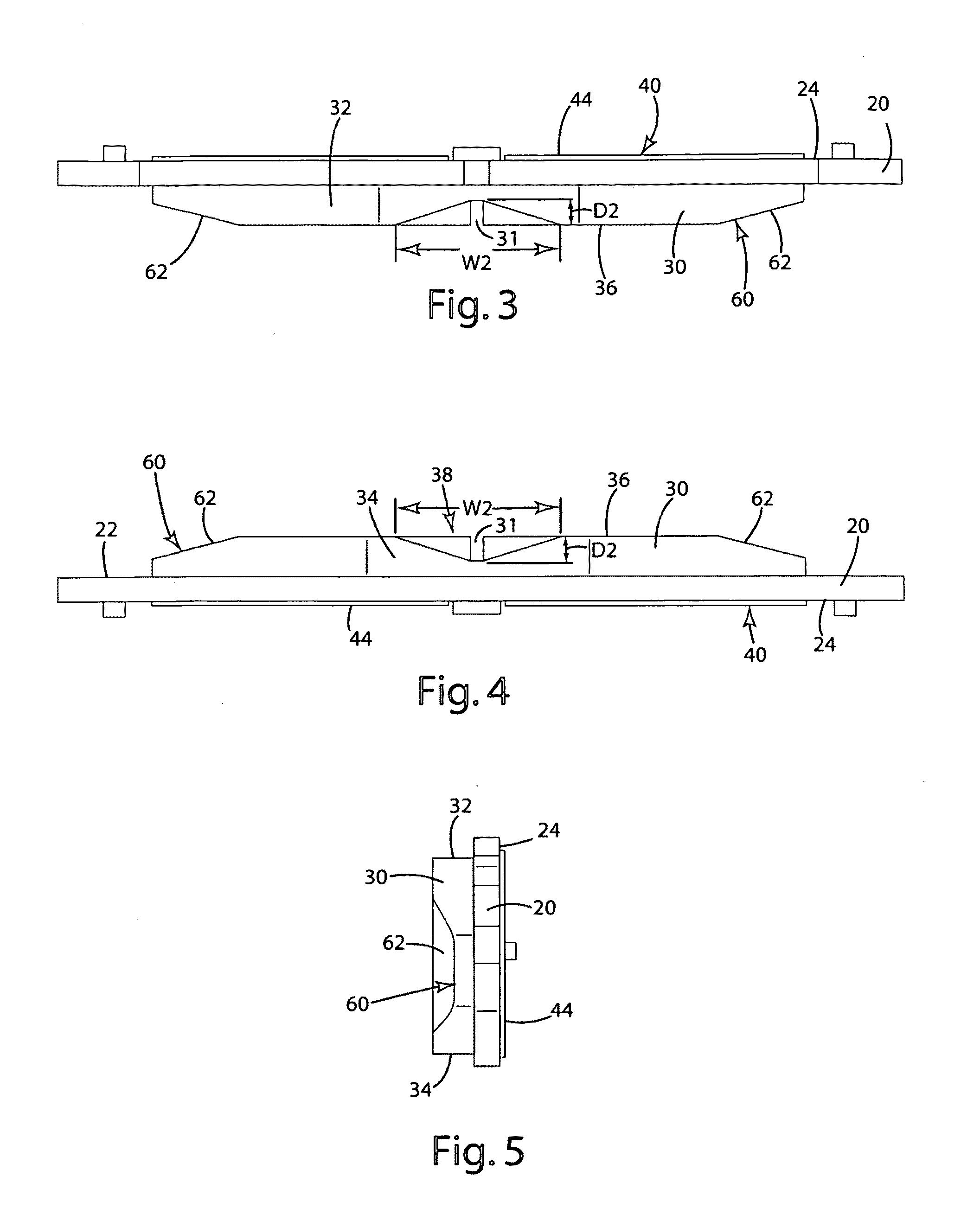Brake Pad
a brake pad and disc brake technology, applied in the field of brakes, can solve the problems of disc brake squeal, disc brake squeal is primarily, and the modification of the rotor rarely provides significant reduction of high frequency squeal
- Summary
- Abstract
- Description
- Claims
- Application Information
AI Technical Summary
Benefits of technology
Problems solved by technology
Method used
Image
Examples
example 1
[0077]FIGS. 7A-B show the original pad shape for brake #1, a minivan application, which includes 15 mm parallel end chamfers 62 and a center slot 31 on both inner and outer pads. FIGS. 8A-C and 9 A-C show some of the primary out of plane mode shapes from the normal mode analysis. It can be seen that high amplitudes exist near the outer edges / corners and top center of the lining surface for the inner pad. For the outer pad, high amplitudes exist near the outer edges as well as top and bottom center of the lining surface. The original 15 mm parallel chamfer 62 is apparently not adequate to reduce the excitation from these modes. Following the methodology outlined in the previous section, the high amplitude areas 70 in the lining surfaces are removed as much as possible.FIG. 10A shows the modified inner pad of FIG. 7A and includes a diamond chamfer 66, center slot 31, and top center V-chamfer 37. FIG. 10B shows the modified inner pad of FIG. 7B and includes a 20 mm parallel chamfer 62,...
example 2
[0078]FIG. 13A shows the original pad shape which includes a parallel chamfer 62 center slot 31. FIG. 13B shows the modified pad shape which includes a parallel chamfer 62, center slot 31, and V-chamfers 37 along both the outer edge 32 and inner edge 34. The primary mode shapes are shown in FIGS. 14A-D. Again, the new design is targeting the removal of high amplitude areas 70 (outer edges, center top and bottom) on the lining surface from these modes. Dynamometer test (SAE J2521) results are shown in FIGS. 15 and 16 for the original pad shape and modified pad shape, respectively. The new pad shape completely eliminated squeals at 10.1 kHz and 6.7 kHz.
example 3
[0079]FIG. 13A shows the original pad shape which includes a parallel chamfer 62. FIG. 13B shows the modified pad shape which includes a diamond chamfer 66. The primary mode shapes are shown in FIGS. 18A-D. The high amplitude areas 70 are outer corners and edges of lining surface. Since the pad profile is more squarely like, cutting a larger parallel chamfer would significantly reduce the lining area, which might create lining life and performance issues. The new diamond chamfer, which preserves lining area over parallel chamfer, was designed to reduce excitation from modes shown in FIG. 18A-D. Dynamometer test (SAE J2521) results are shown in FIGS. 19 and 20 for the original pad shape and modified pad shape, respectively. Again, the diamond chamfer completely eliminated the squeal at 13.2 kHz.
[0080]The same design process for alternative pad shapes was executed for fifteen brake applications including the three applications presented above. The alternative pad shapes include parall...
PUM
 Login to View More
Login to View More Abstract
Description
Claims
Application Information
 Login to View More
Login to View More - R&D
- Intellectual Property
- Life Sciences
- Materials
- Tech Scout
- Unparalleled Data Quality
- Higher Quality Content
- 60% Fewer Hallucinations
Browse by: Latest US Patents, China's latest patents, Technical Efficacy Thesaurus, Application Domain, Technology Topic, Popular Technical Reports.
© 2025 PatSnap. All rights reserved.Legal|Privacy policy|Modern Slavery Act Transparency Statement|Sitemap|About US| Contact US: help@patsnap.com



